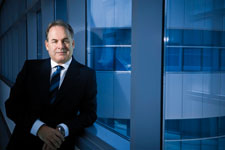Etihad Airways chief executive James Hogan has marked the Abu Dhabi carrier’s seventh birthday by claiming no new airline has grown quicker, and promising to break even by next year.
Etihad – which styles itself the national airline of the United Arab Emirates – expects to carry 7.3 million passengers in 2010. It says local rivals Qatar Airways and Emirates took 13 years and 18 years respectively to reach that point. However, Hogan insists he is “not in a race” with his Gulf-based competitors and simply wants to be “best in class”.
 |
|---|
In an interview with Flightglobal at Etihad’s headquarters, the former Gulf Air and Ansett boss also hit out at critics who accuse the airline of being subsidised by the oil-rich government of Abu Dhabi. “We had start-up capital but our owners expect a return on capital. We have to raise finance. My focus on return on capital and profitability is as aggressive as any airline I’ve worked in,” he says.
Similarly, he denies Etihad gets privileged treatment at its Abu Dhabi hub. Although operator Abu Dhabi Airport Company is also government-owned, Hogan says Etihad, which represents 60% of traffic at Abu Dhabi International, is no more favoured than British Airways, Cathay Pacific or Singapore Airlines are at their domestic bases.
Instead, non-unionised Etihad benefits from not being encumbered by the high legacy costs of its international rivals. “We are not bound by infrastructure that is 50 years old, or 50-year-old scope agreements. They take a long time to change,” he says.
With a 57-strong fleet and the first deliveries of a record-breaking commitment for 200 aircraft placed at the 2008 Farnborough air show beginning to arrive, Hogan says Etihad is “getting to a point where economies of scale are kicking in”.
 |
|---|
Freight has been a major factor in the airline’s recovery. “The growth out of India and China in the past six months has been extraordinary. We are exceeding our business plan,” he says. Etihad earlier this year added two Airbus A330-200Fs to its fleet, taking its dedicated cargo fleet to six, and launched scheduled freight services to Hong Kong, Beijing, Erbil, N’djamena, Narita and Nagoya.
On 31 October, Etihad began its first all-economy services with an Airbus A320 configured with 162 seats to Alexandria, Columbo, Damascus, Thiruvananthapuram, Calicut and Peshawar. However, Hogan insists it is not a move into the low-cost market, but rather a way of “deploying the asset where there’s going to be the best return”. The flights are full-service, and interline to the rest of the Etihad network. “It’s the same brand, the same product,” he says.
Abu Dhabi’s growing popularity as a high-end leisure destination – it hosted the Formula 1 Grand Prix last weekend – is helping Etihad compete with the hubs of its local rivals, says Hogan. About half its passengers now begin or end their journeys in the emirate. “There were very few hotels here when we started. Now we can aggressively target the destination,” he says.
Read our cover interview with James Hogan from October 2008
Source: Airline Business
















